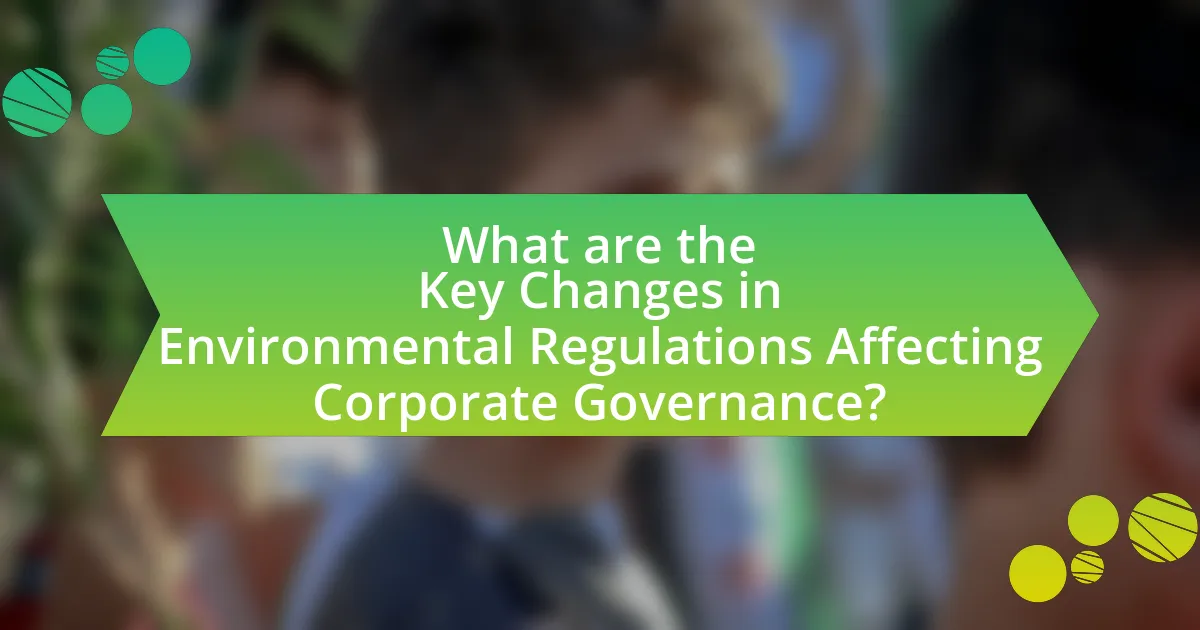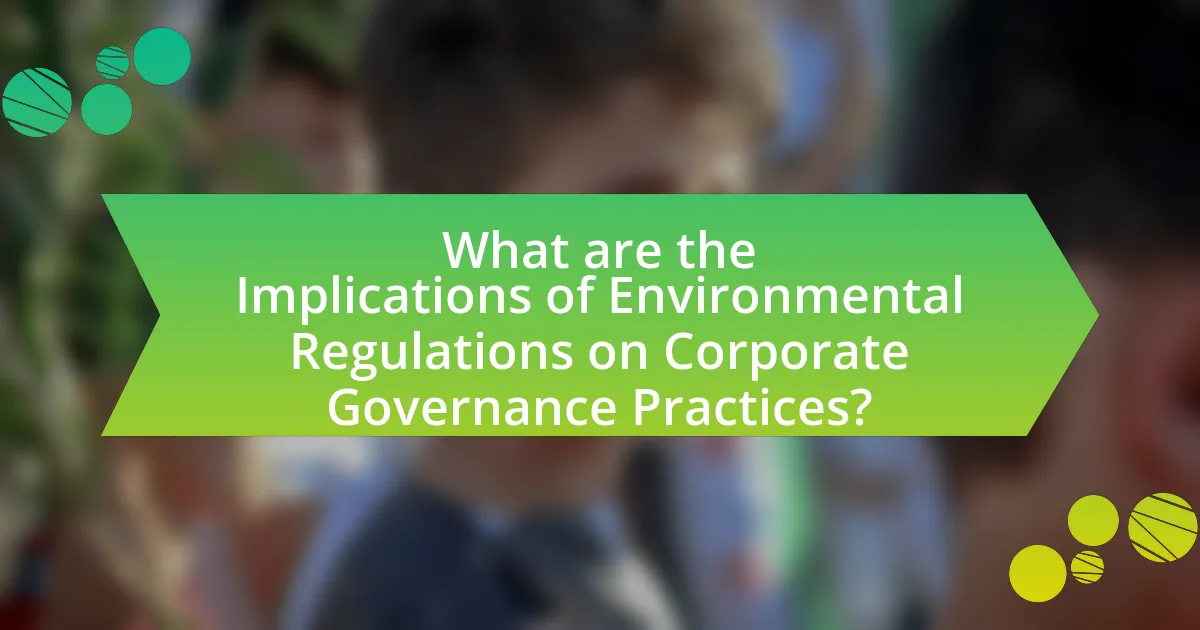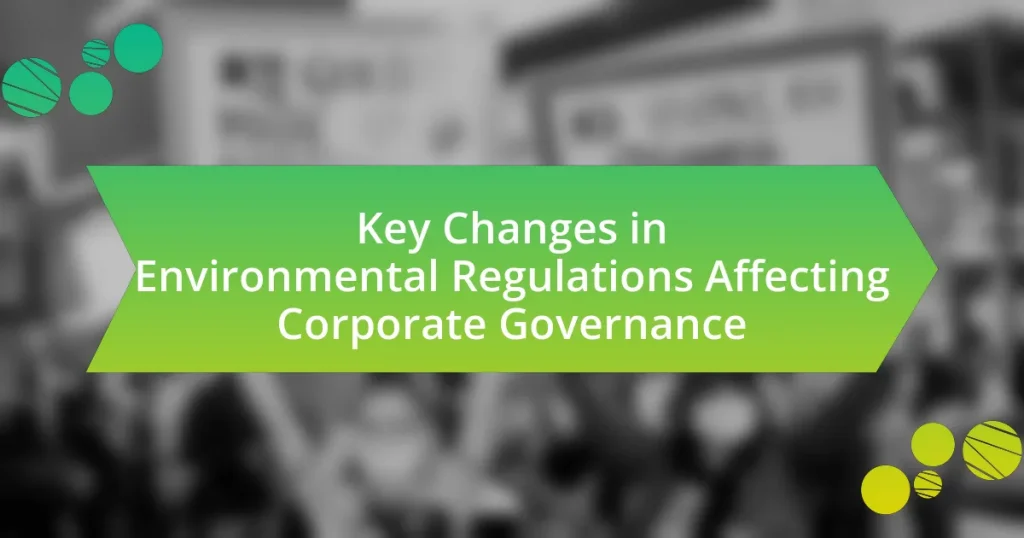The article focuses on key changes in environmental regulations that are significantly impacting corporate governance. It outlines the implementation of stricter emissions standards, increased transparency requirements, and the integration of sustainability into corporate risk assessments, particularly highlighting the European Union’s Green Deal and the U.S. Securities and Exchange Commission’s proposed rules. The discussion includes the evolution of these regulations, their implications for corporate governance frameworks, and the risks corporations face due to non-compliance. Additionally, it emphasizes best practices for corporations to enhance compliance and align their governance structures with environmental sustainability goals.

What are the Key Changes in Environmental Regulations Affecting Corporate Governance?
Key changes in environmental regulations affecting corporate governance include the implementation of stricter emissions standards, increased transparency requirements regarding environmental impact, and the integration of sustainability into corporate risk assessments. For instance, the European Union’s Green Deal mandates that companies disclose their carbon footprints, compelling them to adopt more sustainable practices. Additionally, the U.S. Securities and Exchange Commission has proposed rules requiring public companies to disclose climate-related risks, which directly influences corporate governance by holding boards accountable for environmental performance. These regulatory shifts are designed to enhance corporate responsibility and align business practices with environmental sustainability goals.
How have recent environmental regulations evolved?
Recent environmental regulations have evolved to become more stringent and comprehensive, focusing on climate change mitigation, pollution reduction, and sustainability practices. For instance, the European Union’s Green Deal, introduced in 2019, aims to make Europe the first climate-neutral continent by 2050, mandating significant reductions in greenhouse gas emissions. Additionally, the U.S. has seen a shift with the reintroduction of regulations like the Clean Power Plan, which seeks to limit carbon emissions from power plants. These changes reflect a growing recognition of the need for corporate accountability in environmental impact, as evidenced by the increasing number of companies adopting Environmental, Social, and Governance (ESG) criteria in their operations.
What are the major legislative changes in environmental regulations?
Major legislative changes in environmental regulations include the implementation of the European Green Deal, which aims to make Europe climate-neutral by 2050, and the United States’ Inflation Reduction Act, which allocates significant funding for clean energy initiatives and emissions reductions. The European Green Deal encompasses various regulations, such as stricter emissions standards for vehicles and enhanced protections for biodiversity. The Inflation Reduction Act includes tax incentives for renewable energy projects and aims to reduce greenhouse gas emissions by approximately 40% by 2030 compared to 2005 levels. These legislative changes reflect a global shift towards more stringent environmental protections and corporate accountability in sustainability practices.
How do these changes impact corporate governance frameworks?
Changes in environmental regulations significantly impact corporate governance frameworks by necessitating enhanced accountability and transparency in corporate practices. These regulations compel companies to adopt more rigorous sustainability reporting and risk management strategies, ensuring that environmental considerations are integrated into decision-making processes. For instance, the European Union’s Corporate Sustainability Reporting Directive (CSRD) mandates that large companies disclose their environmental impact, thereby increasing stakeholder scrutiny and influencing board governance structures. This shift towards sustainability not only aligns corporate strategies with regulatory expectations but also fosters a culture of ethical responsibility, ultimately reshaping the governance landscape to prioritize long-term environmental sustainability alongside financial performance.
Why are these changes significant for corporations?
These changes are significant for corporations because they impose stricter compliance requirements and increase accountability regarding environmental impact. Corporations must now adapt their governance structures to align with new regulations, which can lead to increased operational costs and potential legal liabilities. For instance, the implementation of the European Union’s Green Deal mandates that companies reduce greenhouse gas emissions, compelling them to invest in sustainable practices. Failure to comply can result in hefty fines and damage to corporate reputation, as seen in cases where companies faced public backlash for environmental negligence. Thus, these regulatory changes directly influence corporate strategy, risk management, and stakeholder relations.
What risks do corporations face due to non-compliance with new regulations?
Corporations face significant financial, legal, and reputational risks due to non-compliance with new regulations. Financially, non-compliance can result in hefty fines; for instance, the Environmental Protection Agency (EPA) can impose penalties that reach millions of dollars for violations. Legally, corporations may face lawsuits from regulatory bodies or affected parties, leading to costly litigation and settlements. Reputationally, non-compliance can damage a corporation’s public image, resulting in loss of consumer trust and decreased market share. A study by the Harvard Business Review found that companies with strong compliance records tend to outperform their peers, highlighting the importance of adhering to regulations for long-term success.
How can compliance enhance corporate reputation and stakeholder trust?
Compliance enhances corporate reputation and stakeholder trust by demonstrating a commitment to ethical practices and regulatory adherence. When organizations comply with environmental regulations, they signal to stakeholders that they prioritize sustainability and social responsibility, which can lead to increased consumer loyalty and investor confidence. For instance, a study by the Harvard Business Review found that companies with strong compliance programs experience a 20% increase in customer trust and a 15% rise in employee satisfaction. This correlation indicates that effective compliance not only mitigates legal risks but also fosters a positive corporate image, ultimately enhancing stakeholder relationships.

What are the Implications of Environmental Regulations on Corporate Governance Practices?
Environmental regulations significantly influence corporate governance practices by mandating greater transparency and accountability in environmental performance. Companies are increasingly required to disclose their environmental impact, which leads to enhanced stakeholder engagement and the integration of sustainability into corporate strategies. For instance, the implementation of the EU’s Non-Financial Reporting Directive in 2018 necessitated that large companies report on environmental matters, thereby promoting responsible governance. This shift encourages firms to adopt more rigorous environmental policies and practices, aligning corporate objectives with sustainable development goals.
How do environmental regulations influence corporate decision-making?
Environmental regulations significantly influence corporate decision-making by imposing compliance requirements that shape operational strategies. Companies must adapt their practices to meet legal standards, which often leads to increased costs for compliance, investment in cleaner technologies, and changes in product design. For instance, the implementation of the Clean Air Act in the United States required industries to reduce emissions, prompting firms to innovate and adopt more sustainable practices to avoid penalties. This regulatory pressure can also drive companies to enhance their corporate social responsibility initiatives, as stakeholders increasingly demand environmentally friendly practices.
What role do boards of directors play in ensuring compliance?
Boards of directors play a critical role in ensuring compliance by establishing governance frameworks that align with legal and regulatory requirements. They are responsible for overseeing the implementation of compliance programs, ensuring that the organization adheres to environmental regulations and other relevant laws. This oversight includes reviewing compliance policies, monitoring risk management practices, and ensuring that adequate resources are allocated for compliance efforts. For instance, the Sarbanes-Oxley Act mandates that boards must establish internal controls and procedures for financial reporting, which extends to compliance with environmental regulations as part of corporate governance.
How can companies integrate sustainability into their governance structures?
Companies can integrate sustainability into their governance structures by establishing dedicated sustainability committees within their boards. These committees are responsible for overseeing sustainability initiatives, ensuring compliance with environmental regulations, and aligning corporate strategies with sustainable practices. For instance, a study by the Harvard Business Review found that companies with sustainability committees are more likely to achieve better environmental performance and stakeholder engagement. Additionally, integrating sustainability metrics into executive compensation can further incentivize leadership to prioritize sustainable practices, as evidenced by research from the Global Reporting Initiative, which indicates that companies linking pay to sustainability outcomes see improved long-term performance.
What are the challenges corporations face in adapting to these regulations?
Corporations face significant challenges in adapting to new environmental regulations, primarily due to the complexity and variability of compliance requirements. These regulations often require substantial changes in operational processes, which can lead to increased costs and resource allocation. For instance, a study by the World Economic Forum indicates that companies may need to invest up to 10% of their annual revenue to meet stringent environmental standards. Additionally, the rapid pace of regulatory changes can create uncertainty, making it difficult for corporations to develop long-term strategies. This uncertainty is compounded by the need for ongoing employee training and the integration of new technologies to ensure compliance, further straining corporate resources.
What are the common obstacles in implementing new governance practices?
Common obstacles in implementing new governance practices include resistance to change, lack of stakeholder engagement, insufficient resources, and inadequate training. Resistance to change often stems from established organizational cultures that are hesitant to adopt new practices. Lack of stakeholder engagement can lead to misalignment between governance goals and the interests of key parties, resulting in ineffective implementation. Insufficient resources, both financial and human, can hinder the ability to execute new governance frameworks effectively. Additionally, inadequate training can leave employees unprepared to adapt to new governance practices, further complicating the implementation process. These factors collectively impede the successful adoption of governance changes, particularly in the context of evolving environmental regulations.
How can companies overcome resistance to change within their organizations?
Companies can overcome resistance to change within their organizations by fostering open communication and involving employees in the change process. Engaging employees through transparent discussions about the reasons for change and soliciting their input can reduce anxiety and build trust. Research indicates that organizations that prioritize employee involvement in change initiatives experience a 70% success rate in implementing changes effectively, as highlighted in a study by Kotter International. This approach not only addresses concerns but also empowers employees, making them more likely to support and adapt to new regulations and practices.

What Best Practices Should Corporations Adopt in Response to Environmental Regulations?
Corporations should adopt proactive compliance strategies, including regular environmental audits, to effectively respond to environmental regulations. Implementing these audits allows companies to identify potential compliance gaps and mitigate risks associated with regulatory penalties. Additionally, integrating sustainability into corporate governance frameworks ensures that environmental considerations are prioritized in decision-making processes. For instance, a study by the World Economic Forum found that companies with strong environmental governance practices can reduce operational costs by up to 20% while enhancing their reputation. Furthermore, engaging stakeholders through transparent reporting and communication fosters trust and accountability, aligning corporate practices with regulatory expectations.
How can companies develop effective compliance strategies?
Companies can develop effective compliance strategies by conducting thorough risk assessments to identify regulatory requirements and potential compliance gaps. This process involves analyzing current operations against applicable environmental regulations, such as the Clean Air Act and the Clean Water Act, to ensure adherence. Implementing a robust compliance management system, which includes training employees on regulatory obligations and establishing clear reporting mechanisms, further strengthens compliance efforts. Research indicates that organizations with comprehensive compliance programs experience fewer violations and penalties, as evidenced by a study from the Association of Certified Fraud Examiners, which found that companies with strong compliance frameworks reduce their risk of legal issues by up to 50%. Regular audits and updates to compliance strategies in response to evolving regulations also play a crucial role in maintaining effectiveness.
What tools and resources are available for monitoring regulatory changes?
Tools and resources available for monitoring regulatory changes include regulatory tracking software, legal research databases, and industry-specific news platforms. Regulatory tracking software, such as Compliance.ai and RegTech solutions, provide real-time updates on changes in regulations relevant to specific industries. Legal research databases like Westlaw and LexisNexis offer comprehensive access to legal documents and regulatory updates. Additionally, industry-specific news platforms, such as Environmental Leader and GreenBiz, deliver targeted news and analysis on environmental regulations affecting corporate governance. These resources enable organizations to stay informed and compliant with evolving regulatory landscapes.
How can training and education improve compliance among employees?
Training and education can significantly improve compliance among employees by enhancing their understanding of regulations and fostering a culture of accountability. When employees receive targeted training on environmental regulations, they become more aware of the specific requirements and implications of non-compliance, which can lead to better adherence to policies. For instance, a study by the National Institute of Standards and Technology found that organizations with comprehensive training programs experienced a 30% reduction in compliance violations. This demonstrates that informed employees are more likely to follow guidelines and contribute to a compliant organizational environment.
What are the benefits of proactive environmental governance?
Proactive environmental governance leads to enhanced sustainability, improved corporate reputation, and reduced regulatory risks. By anticipating environmental challenges and implementing strategies to address them, organizations can minimize their ecological footprint and foster long-term viability. For instance, companies that adopt proactive measures often experience a 20% reduction in operational costs related to waste management and energy consumption, as reported by the World Economic Forum. Additionally, proactive governance can enhance stakeholder trust, as consumers increasingly favor brands committed to environmental responsibility, leading to increased market share and customer loyalty.
How does proactive governance lead to competitive advantages?
Proactive governance leads to competitive advantages by enabling organizations to anticipate and adapt to regulatory changes effectively. This forward-thinking approach allows companies to align their operations with evolving environmental regulations, reducing compliance risks and potential penalties. For instance, firms that adopt sustainable practices early can enhance their brand reputation and attract environmentally conscious consumers, resulting in increased market share. Research indicates that companies with strong environmental governance outperform their peers financially, as they are better positioned to capitalize on emerging opportunities and mitigate risks associated with regulatory non-compliance.
What examples exist of companies successfully navigating these changes?
Companies such as Unilever and Tesla have successfully navigated changes in environmental regulations affecting corporate governance. Unilever has implemented sustainable sourcing practices and set ambitious targets for reducing greenhouse gas emissions, achieving a 52% reduction in emissions from its products since 2010. Tesla, on the other hand, has focused on electric vehicle production and renewable energy solutions, positioning itself as a leader in the transition to sustainable transportation. These companies demonstrate effective adaptation to regulatory changes through innovative practices and commitment to sustainability.
What practical steps can corporations take to align with environmental regulations?
Corporations can align with environmental regulations by implementing comprehensive sustainability strategies. These strategies should include conducting regular environmental impact assessments to identify compliance gaps, investing in cleaner technologies to reduce emissions, and adopting sustainable sourcing practices to minimize resource depletion. For instance, a study by the World Economic Forum indicates that companies adopting such measures can reduce their carbon footprint by up to 30%. Additionally, corporations should establish robust reporting mechanisms to track compliance with regulations and engage stakeholders in sustainability initiatives, thereby fostering transparency and accountability.






